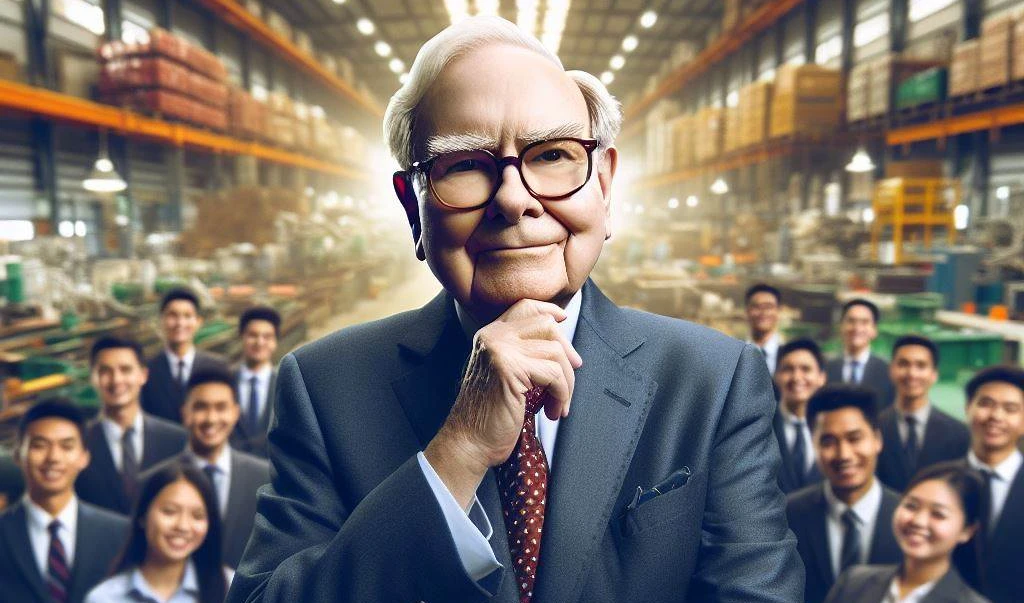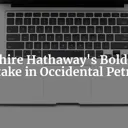Tags: Earnings / Share Buyback / Comments
This fanpage is not officially affiliated with Berkshire Hathaway: Disclaimer
Calling all Berkshire Hathaway shareholders! Unveil the true powerhouse of your investment with an in-depth exploration of the conglomerate's diverse empire and the pivotal role of its subsidiaries. Discover the PoOE metric and its possibility for Berkshire's valuation, along with insights into the company's financial health and strategic initiatives. Don't miss out on understanding the depth of Berkshire's business model and the strength of its unique investment philosophy.

Introduction: The Berkshire Misconception
The name Berkshire Hathaway often conjures images of a monolithic insurance giant or a mere holding company, an oversimplification that overlooks the conglomerate's multifaceted nature 1. At the helm of this diverse empire stand Warren Buffett and Charlie Munger, the legendary duo whose value investing principles have steered the company's extraordinary growth. Berkshire Hathaway's reach extends across a spectrum of industries, including confectionery, retail, railroads, and energy distribution, to name a few 1. The company's book value has soared at an average rate of 20%, outpacing the S&P 500's 10% growth when dividends are factored in 1.
As we delve into the true powerhouse behind Berkshire Hathaway, we will suggest the following metric: Price-over-Operating-Earnings (PoOE). This measure, which divides the company's operating earnings by its market capitalization, offers a more nuanced view of Berkshire's performance, especially when juxtaposed with the current S&P 500 PE ratio 5. This article aims to dismantle the prevalent misconception by shining a light on the PoOE metric and the strength of Berkshire's subsidiaries, elaborating on the conglomerate's true value.
The Diverse Empire of Berkshire Hathaway
Berkshire Hathaway's portfolio is a tapestry of businesses spanning from sweets to utilities 1 ↗. These subsidiaries are not mere accessories; they are the engine of Berkshire's success. The insurance sector, while central to providing investment capital, is just the starting point. The company's strategic acquisitions and equity stakes have formed a robust and resilient commercial fortress.
Take, for instance, BNSF Railway ↗ and Berkshire Hathaway Energy (BHE) ↗, whose contributions to earnings are substantial 2. The recent consolidation of PTC into Berkshire's operations, increasing its ownership to 80%, exemplifies the company's aggressive expansion strategy 2. The diversity of revenue streams from these subsidiaries fortifies Berkshire against economic headwinds and fuels its continuous growth.
Insurance: The Float and Beyond. The "float"—premiums held before claims are paid—serves as Berkshire's war chest, propelling its investment ventures 1 ↗. The Q3 2023 earnings from insurance underwriting alone reached $2.4 billion, a testament to the company's strategic prowess in managing low catastrophe losses 2. The Property & Casualty Operations saw a 6% uptick in net written premiums, while underwriting income surged by 56% year over year 3. These figures underscore the insurance division's pivotal role in not only underpinning Berkshire's investment capacity but also in enhancing its financial stability.
Berkshire's Subsidiaries: The Unsung Heroes. Despite BNSF's 15.3% earnings dip in Q3 2023 and BHE's 68.9% earnings decline, Berkshire's operating earnings still grew by an impressive 40.6% 23. This resilience underscores the subsidiaries' vital role in maintaining a steady cash flow and the conglomerate's overall health. These entities are not just part of Berkshire; they are its backbone, often providing a more reliable gauge of the company's strength than its stock portfolio alone.

The Metric That Matters: Price-over-Operating-Earnings (PoOE)
When evaluating the financial health and valuation of a large, diversified company like Berkshire Hathaway, traditional metrics such as the Price-to-Earnings (PE) ratio may not always provide the most accurate picture. This is where the Price-over-Operating-Earnings (PoOE) metric comes into play, particularly as a more suitable alternative for assessing conglomerates with varied subsidiary operations.
The PoOE ratio is calculated by dividing a company's market capitalization by its operating earnings. For Berkshire Hathaway, this involves using the latest reported operating earnings and the company's current market capitalization 4. Operating earnings are a measure of the profits generated from the company's core business activities, excluding non-operating income such as investments or one-time gains or losses.
To put Berkshire's valuation into perspective using the PoOE metric, we can compare it against the S&P 500's PE ratio. The PE ratio, which compares a company's share price to its per-share earnings, is a widely used benchmark for stock valuation. However, for a company like Berkshire, which has significant investment income that can cause fluctuations in its net earnings, focusing on operating earnings can provide a clearer view of the company's ongoing business performance.
As of the latest data, Berkshire Hathaway's market capitalization stands at $775.283 billion 4. With reported operating earnings for Q3 2023 at $10.8 billion 3, we can extrapolate an estimated annual operating earnings figure of about $40 billion, assuming earnings remain consistent throughout the year. This yields an estimated PoOE ratio of approximately 19.4, which of course is very coarse. Nevertheless, this figure offers investors a lens through which to assess Berkshire's valuation in comparison to the S&P 500's PE ratio of 26.27 and its historical mean of 16.04 5. As with all metrics, the PoOE must be taken with a grain of salt as well!
| Metric | Value |
|---|---|
| Berkshire's Est. 2023 PoOE Ratio | 19.4 |
| S&P 500's current PE Ratio | 26.3 |
It is important to note that Berkshire Hathaway's PoOE ratio intentionally excludes investment income from its substantial stock holdings. This exclusion is key to understanding the metric, as it focuses solely on the earnings power derived from the company's operational activities, rather than the potentially volatile returns from its investment portfolio.
Berkshire Hathaway shareholders may use the PoOE ratio to make preliminary judgments about Berkshire Hathaway's relative value compared to the broader market as represented by the S&P 500. The judgement might be defensive, since it excludes possible investment income earnings. A PoOE ratio that is lower than the S&P 500's PE ratio may indicate that Berkshire is undervalued relative to the market, particularly when considering the strength and stability of its operating earnings. Conversely, a higher PoOE ratio would suggest that Berkshire's stock might be priced at a premium.
Ultimately, the PoOE metric might be a valuable tool for those looking to gauge the intrinsic value of Berkshire Hathaway, as it provides a focused measure of the company's earning power without the noise of investment gains or losses. Each investor, however, must consider their own risk tolerance, investment strategy, and the broader economic context when making investment decisions based on these or any other financial metrics. Please note again that we do not provide investment advice on brk-b.com, see also our disclaimer below.
Shareholder Value: Buybacks and Equity Growth
Berkshire's repurchase of $7 billion worth of shares in the first nine months of 2023 speaks volumes about its commitment to shareholder value 3 ↗. The company's consolidated shareholders’ equity has climbed by 10.3%, reflecting a robust financial foundation 3. Share buybacks not only enhance shareholder value but also influence the PoOE metric, signaling management's belief in the intrinsic value of the company and striking a balance between rewarding shareholders and retaining capital for future ventures.
The Financial Health of Berkshire Hathaway
The dip in cash and cash equivalents by 20.7% from the end of 2022, coupled with a 28.7% rise in cash flow from operating activities, paints a picture of a company that is strategically deploying its resources 3. The meticulous management of expenses, which decreased by 1.4% year over year, alongside a 21.2% revenue increase, highlights Berkshire's financial acumen 3. This robust financial health is the bedrock upon which the conglomerate's long-term investment strategies and subsidiary support are built.

Conclusion: The Berkshire Reality
This exploration has laid bare the misconception surrounding Berkshire Hathaway, revealing a conglomerate whose strength lies not just in its stock portfolio but in the robustness of its subsidiaries ↗. The PoOE metric has emerged as a pivotal tool in assessing Berkshire's true value, offering a more comprehensive understanding of the company's diverse operations. Shareholders and investors are urged to recognize the depth of Berkshire's business model, as evidenced by the solid performance across its varied segments 3. In closing, Berkshire Hathaway stands as a paragon of a unique investment philosophy and business strategy, commanding confidence and respect in the financial world.
References












